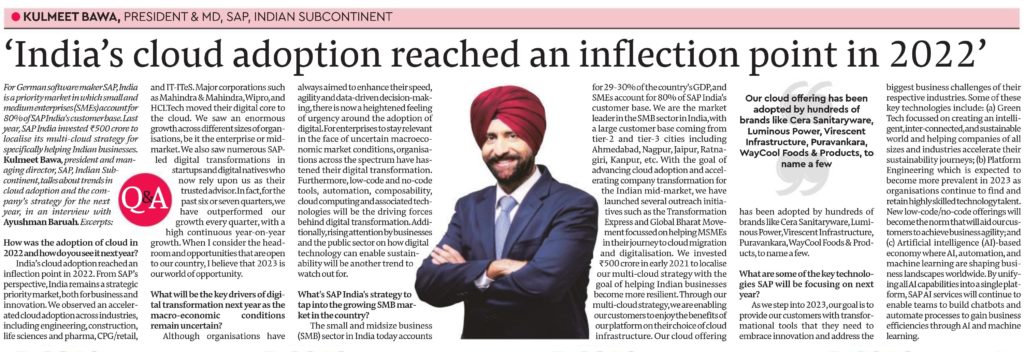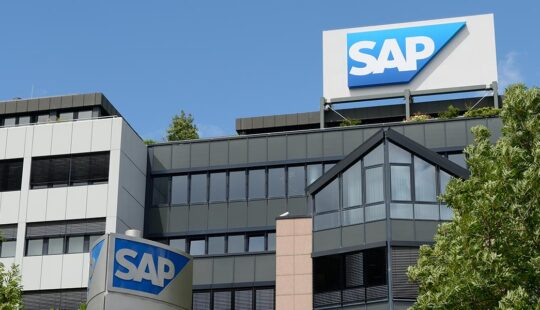From SAP’s perspective, India remains a strategic priority market, both for business and innovation.
For German software maker, SAP, India is a priority market in which small and medium enterprises (SMEs) account for 80% of SAP India’s customer base. Last year, SAP India invested `500 crore to localize its multi-cloud strategy for specifically helping Indian businesses. Kulmeet Bawa, President and Managing Director, SAP Indian Subcontinent, talks about trends in cloud adoption and the company’s strategy for the next year, in an interview with Ayushman Baruah.
Excerpts:
How was the adoption of cloud in 2022 and how do you see it next year?
India’s cloud adoption reached an inflection point in 2022. From SAP’s perspective, India remains a strategic priority market, both for business and innovation. We observed an accelerated cloud adoption across industries, including engineering, construction, life sciences and pharma, CPG/retail, and IT-ITeS. Major corporations such as Mahindra & Mahindra, Wipro, and HCL Tech moved their digital core to the cloud. We saw an enormous growth across different sizes of organizations, be it the enterprise or midmarket. We also saw numerous SAP-led digital transformations in start-ups and digital natives who now rely upon us as their trusted advisor. In fact, for the past six or seven quarters, we have outperformed our growth every quarter, with a high continuous year-on-year growth. When I consider the headroom and opportunities that are open to our country, I believe that 2023 is our world of opportunity.
What will be the key drivers of digital transformation next year as the macro-economic conditions remain uncertain?
Although organizations have always aimed to enhance their speed, agility, and data-driven decision-making, there is now a heightened feeling of urgency around the adoption of digital. For enterprises to stay relevant in the face of uncertain macroeconomic market conditions, organizations across the spectrum have hastened their digital transformation. Furthermore, low-code and no-code tools, automation, composability, cloud computing, and associated technologies will be the driving forces behind digital transformation. Additionally, rising attention by businesses and the public sector on how digital technology can enable sustainability will be another trend to watch out for.
What’s SAP India’s strategy to tap into the growing SMB market in the country?
The small and midsize business (SMB) sector in India today accounts for 29-30% of the country’s GDP, and SMEs account for 80% of SAP India’s customer base. We are the market leader in the SMB sector in India, with a large customer base coming from tier-2 and tier-3 cities including Ahmedabad, Nagpur, Jaipur, Ratnagiri, Kanpur, etc. With the goal of advancing cloud adoption and accelerating company transformation for the Indian mid-market, we have launched several outreach initiatives such as the Transformation Express and Global Bharat Movement focused on helping MSMEs in their journey to cloud migration and digitalization. We invested `500 crore in early 2021 to localize our multi-cloud strategy with the goal of helping Indian businesses become more resilient. Through our multi-cloud strategy, we are enabling our customers to enjoy the benefits of our platform on their choice of cloud infrastructure. Our cloud offering has been adopted by hundreds of brands like Cera Sanitaryware, Luminous Power, Virescent Infrastructure, Puravankara, WayCool Foods & Products, to name a few.
What are some of the key technologies SAP will be focusing on next year?
As we step into 2023, our goal is to provide our customers with transformational tools that they need to embrace innovation and address the biggest business challenges of their respective industries. Some of these key technologies include: (a) Green Tech focused on creating an intelligent, inter-connected, and sustainable world and helping companies of all sizes and industries accelerate their sustainability journeys; (b) Platform Engineering which is expected to become more prevalent in 2023 as organizations continue to find and retain highly skilled technology talent. New low-code/no-code offerings will become the norm that will aid our customers to achieve business agility; and (c) Artificial intelligence (AI)-based economy where AI, automation, and machine learning are shaping business landscapes worldwide. By unifying all AI capabilities into a single platform, SAP AI services will continue to enable teams to build chatbots and automate processes to gain business efficiencies through AI and machine learning.
The interview was originally published in The Financial Express on December 21, 2022.




